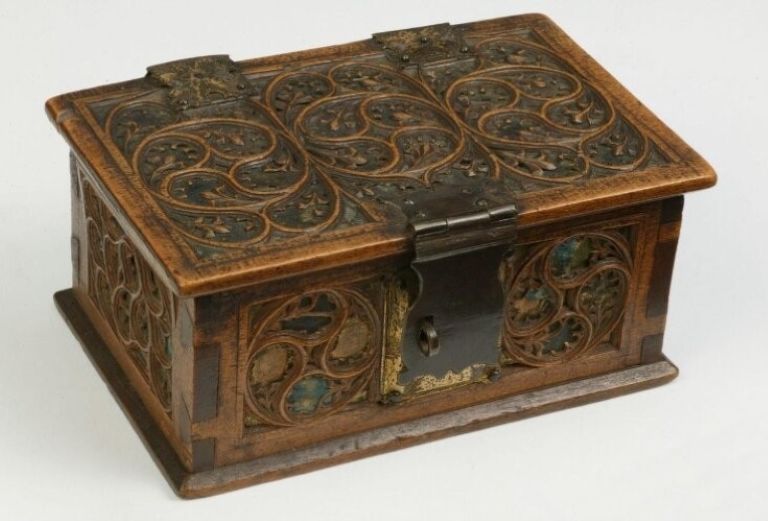
by Nica Olivendal, learning placement student
This decorative finial was found during the Dovecote dig in 2017 and its form and function had me puzzled from the first time I saw it. What is it and what was it used for?
One theory is that it is a stapled hasp, a part of a lock mechanism for a chest or casket. Due to the liturgical nature of Fulham Palace I desperately wished for this to have been part of a reliquary. However, no relics have been found on the palace site, and it is therefore unlikely to have been the case.
We know that it is made from copper alloy, and that it is dated to AD 1066-1485. We also know that it is a small object since it can fit into the palm of a hand.
The right end of the finial has a rectangular frame shape, whereas the left side is shaped as a decorative leaf with fine engravings in the form of leaf veins. The head of the finial, the leaf, has been twisted from its original shape, but when or how this has happened is difficult to say.
Medieval houses did not have built-in storage like modern houses do. Instead, large wooden chests were used for storing textiles and bed linen. For more valuable items like jewellery, money and ceremonial objects such as candlesticks or silver cups, thick wooden caskets reinforced with metal would have been used instead. Everything had a value, so both chests and caskets would have locks to keep out visitors and servants. Caskets were often ornate, and not owned by the poor.

Because of its small size the finial has most probably belonged to a smaller casket, but no parts of the actual casket it belonged to has been discovered, so it is difficult to know exactly what it would have looked like. However, we can make a guess based on other similar objects dated from roughly the same time.
Perhaps the finial belonged to a wooden casket that has deteriorated in the ground. I have scanned every digital archive I have had access to in order to find clues, but no objects that resemble the finial have been found. However, I did manage to find two examples of wooden caskets with a similar lock mechanism of a staple and hasp.
The problem is that even though the mechanism is the same, the Fulham Palace finial does not match the two other examples. The finial is more decorative, whereas the German/Flemish staple is made from a square base that has been screwed or bolted onto the wooden casket. In the case of the Catalonian casket the staple has been attached to the casket from the inside. Because of its ornaments the finial would most likely have been attached to the outside of the casket, to function as a decoration as well as a lock.

So far it seems like the finial found during the Dovecote dig is truly a unique piece, or perhaps it is not what we believe it to be. It seems more questions have been raised rather than answered and the true origin of this decorative finial remains a mystery. You can visit our finial when our museum is able to reopen safely! Until then, watch Alexis Haslam discuss the finial and other medieval archaeology in our museum in this episode of museum from home.